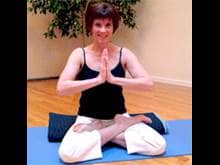
Anyone who has lived with chronic pain knows how physically, mentally and emotionally debilitating it can be. We can become unable to understand how one part of our body could "do this to us." We can feel frustrated, angry, and ultimately hopeless.
Yoga includes a range of practices that can help. Rather than seeing the body as a number of different parts, with some that are comfortable and strong while others are weak and painful, yoga considers the body to be an organic, connected entity whose parts are constantly in moving relationship to each other. Yoga teaches awareness of proper body alignment and posture, an important aspect of a well-functioning body. At the same time, the mindfulness training of yoga provides tools for engaging with our pain in a way in which we can listen to it, come to understand it, and abide it while healing is in process. Stress reduction, a well-known benefit of yoga, can further facilitate the release of negative and damaging emotions to help you move towards healing.
This sequence of yoga asanas (poses) is designed to both stretch and strengthen your body. While you practice the sequence, remember that you are not responsible for your pain, but you must be responsible to it. Decide which poses help you to feel better. Offer mental comfort to your painful areas and listen closely to them: You may be surprised by a sense of delight and accomplishment as you help your body become more vital, healthy, and happy.
Hints for Practice
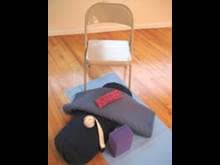 Above all, it is important to listen to the wisdom within your body when dealing with chronic pain. The body can tell you what it needs and what should be avoided. Choose the poses from this sequence that speak to your body in a positive way, and avoid movements that cause stress or discomfort. Also:
Above all, it is important to listen to the wisdom within your body when dealing with chronic pain. The body can tell you what it needs and what should be avoided. Choose the poses from this sequence that speak to your body in a positive way, and avoid movements that cause stress or discomfort. Also:Lying Leg Stretch
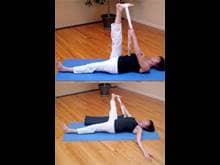 Lie on your back with your legs on the floor. Draw your right knee into your chest and place a belt around your right foot. Stretch your right leg straight and upward towards the ceiling. Stretch your leg upwards as you inhale and draw your foot towards your head as you exhale. Then take your right leg to the right and down towards the floor while you keep your left hip grounded. To balance your hips, place a folded blanket against your outer right hip. Repeat with the left leg.
Lie on your back with your legs on the floor. Draw your right knee into your chest and place a belt around your right foot. Stretch your right leg straight and upward towards the ceiling. Stretch your leg upwards as you inhale and draw your foot towards your head as you exhale. Then take your right leg to the right and down towards the floor while you keep your left hip grounded. To balance your hips, place a folded blanket against your outer right hip. Repeat with the left leg.Reflection: Know Your Body
Yoga practice provides time and mental space for you to develop intuition and understanding about your body. While in this deep stretch to the legs, hips and lower spinal muscles, notice where your body holds pain as well as excess tension, which can amplify pain and discomfort. As you remain in the pose, see if your body can let go of tension and holding. Honor
these sensations as guides that bring you
into your potential for healing.
Eagle Shoulder/Back Stretch
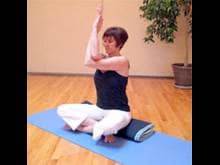 Sit comfortably on a folded blanket or in a chair. Lift your arms forward and to shoulder height and cross your right arm over your left arm above the elbow. Lift your forearms up towards the ceiling and bring your palms together, or hold a belt with both hands. As you inhale, raise your elbows upward and feel a powerful stretch to the upper back and shoulders, places we typically hold tension. You can tuck your chin towards your chest to add a stretch to the back of your neck. Repeat with left arm over right.
Sit comfortably on a folded blanket or in a chair. Lift your arms forward and to shoulder height and cross your right arm over your left arm above the elbow. Lift your forearms up towards the ceiling and bring your palms together, or hold a belt with both hands. As you inhale, raise your elbows upward and feel a powerful stretch to the upper back and shoulders, places we typically hold tension. You can tuck your chin towards your chest to add a stretch to the back of your neck. Repeat with left arm over right.Reflection: Calm The Mind To
Calm The Body
While in this pose, inhale deeply into an area of discomfort and hold the breath a few moments. Exhale very slowly and deeply, letting any anxiety or emotional stress that is accompanying the pain release along with the out breath. Ask each exhale to bring calmness and quiet to your mind and nervous system. As well as calming your emotional responses to pain, your brain will send messages of calming to your body, and you will find insights into dealing with physical pain.
Bridge Pose
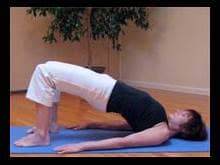 Lie on your back with the soles of your feet on the floor, hips' distance apart from each other, hands by your sides. With an inhale, lift your hips upward starting from your tailbone, then from your buttocks, and then lift your back ribs. Lift the tip of your tailbone strongly upward to elongate your lower back. Feel how this pose strengthens the back, hips, and legs. Release slowly with an exhalation keeping the tailbone tucked and coming down vertebra by vertebra.
Lie on your back with the soles of your feet on the floor, hips' distance apart from each other, hands by your sides. With an inhale, lift your hips upward starting from your tailbone, then from your buttocks, and then lift your back ribs. Lift the tip of your tailbone strongly upward to elongate your lower back. Feel how this pose strengthens the back, hips, and legs. Release slowly with an exhalation keeping the tailbone tucked and coming down vertebra by vertebra.Reflection: The Importance Of Movement
Gentle movements support the body's healing process on many levels. The body's structural system of bones and muscles is kept strong yet fluid, the lungs receive and distribute more healing oxygen throughout the body, the organic body is massaged, and the body produces chemicals that help you feel psychologically better and enhance the experience of movement.
Wide-Leg Seated Pose
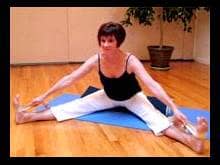 Sit upright on a folded blanket with your legs wide apart from each other. Hold your feet with your hands or with belts. Elongate your spine upward as you inhale, and as you exhale bend from your hips to come into a forward bend with your spine long and soft. Feel how this pose gives a stretch to the legs and hips while it tones the abdominal muscles and back.
Sit upright on a folded blanket with your legs wide apart from each other. Hold your feet with your hands or with belts. Elongate your spine upward as you inhale, and as you exhale bend from your hips to come into a forward bend with your spine long and soft. Feel how this pose gives a stretch to the legs and hips while it tones the abdominal muscles and back.Reflection: Honor Limitations
Pain is often a message of physical limitation which must be honored for the body to heal. In daily life as well as in yoga, be mindful of movements that create or intensify pain. If there isn't a way to modify painful activities for more comfort, let go of them for the present. Being responsive to present limitations is more important than what or how much you do. As your body heals, you will be able to enjoy a wider range of movement and activity.
Modified Boat Pose
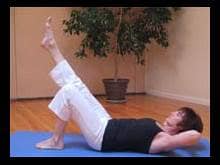 Lie down on your back with hands under your head, and place your feet flat on the floor. Feel that your lower back is relaxed and elongating along the floor. Moving with an exhale, take your right leg straight out at a 45-degree angle to the floor and curl your shoulders up. Be mindful not to move from or strain your neck; rather, support your head fully in your hands and curl up using your abdominal muscles. Feel strength and warmth coming into your abdomen. Rest a few moments, then repeat with left leg lifting.
Lie down on your back with hands under your head, and place your feet flat on the floor. Feel that your lower back is relaxed and elongating along the floor. Moving with an exhale, take your right leg straight out at a 45-degree angle to the floor and curl your shoulders up. Be mindful not to move from or strain your neck; rather, support your head fully in your hands and curl up using your abdominal muscles. Feel strength and warmth coming into your abdomen. Rest a few moments, then repeat with left leg lifting.Reflection: Be In The Present
Visit an area of discomfort and ask how that area is feeling at that moment. Move on to the next moment, and then the next, each time with a fresh mind, asking again how the area feels. Release the pain of each past moment as if you are watching a cloud that moves through the sky and then dissolves. Feel your emotions around pain becoming less reactive and calmer in each moment, coming to understand how to abide and take care of pain.
Half Forward Bend
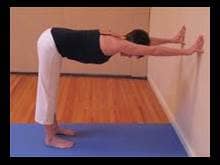 Stand facing a wall and place your fingertips on the wall at waist height. Slowly step your legs back until your spine is parallel to the wall and your hips are over your ankles. Release your shoulder blades down towards your waist, look down, and elongate through the crown of your head. Press your hips away from the wall. Feel your spine, waist, and ribcage lengthening. To come out, bend your knees, walk towards the wall and come back to standing. Feel your spine tall and open.
Stand facing a wall and place your fingertips on the wall at waist height. Slowly step your legs back until your spine is parallel to the wall and your hips are over your ankles. Release your shoulder blades down towards your waist, look down, and elongate through the crown of your head. Press your hips away from the wall. Feel your spine, waist, and ribcage lengthening. To come out, bend your knees, walk towards the wall and come back to standing. Feel your spine tall and open.Reflection: Cultivate Kindness And Compassion
Sometimes it is unavoidable that the mind becomes anxious and fearful when pain is present. Observe your thoughts in a non-judgmental way and replace them with thoughts that your body/mind isn't overwhelmed by. Instead of "My body just doesn't cooperate with me anymore!" consider "My body is not ready to move right now as I would like to. I trust that as it heals, day-by-day, my body will show me what it is ready to do."
Mountain Pose with Shoulder Stretch
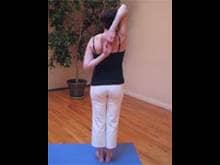 Stand with your feet and legs together and lift up from the base of your hips through the crown of your head. Reach your left arm around to your back. Lift your right arm upward and take the right hand down to the nape of your neck. Now walk the hands towards one another and clasp. If you can't clasp, hold a belt with both hands. Keeping your spine tall and your chest broad, lift the right elbow strongly upward and enjoy length and space at the right arm, ribs, and through the shoulder girdle. Repeat on the other side.
Stand with your feet and legs together and lift up from the base of your hips through the crown of your head. Reach your left arm around to your back. Lift your right arm upward and take the right hand down to the nape of your neck. Now walk the hands towards one another and clasp. If you can't clasp, hold a belt with both hands. Keeping your spine tall and your chest broad, lift the right elbow strongly upward and enjoy length and space at the right arm, ribs, and through the shoulder girdle. Repeat on the other side.Reflection: Body/Mind Connection
The body and the mind each have their own natural wisdoms. Creating dialogue and understanding between the two integrates their wisdoms and creates a powerful union. Then you live in a state of "embodied presence," where relationship to pain is focused on nurturance and becoming whole, rather than in a disembodied existence where pain is ignored and misunderstood.
Supported Triangle
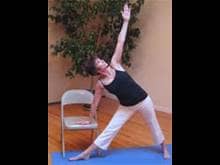 Stand with your feet 4 feet apart, hands on your hips. Turn your right leg and foot outward and turn your left foot slightly inward (to your right). Stretch your arms up to shoulder height at your sides. Reach your spine upward with a deep inhale, and as you exhale reach to your right through your right arm, right ribs, and spine. Place your right hand on a chair. Lift your left arm up towards the ceiling, and, if it's comfortable in your neck, look up at your left hand. Feel length through your legs and the left side of your spine while your hips become open and fluid. Repeat to the left.
Stand with your feet 4 feet apart, hands on your hips. Turn your right leg and foot outward and turn your left foot slightly inward (to your right). Stretch your arms up to shoulder height at your sides. Reach your spine upward with a deep inhale, and as you exhale reach to your right through your right arm, right ribs, and spine. Place your right hand on a chair. Lift your left arm up towards the ceiling, and, if it's comfortable in your neck, look up at your left hand. Feel length through your legs and the left side of your spine while your hips become open and fluid. Repeat to the left.Reflection: The Color Of Pain
Using color imagery at an area of pain is a mental tool for relieving emotions surrounding pain. The intensity of lumbar pain might be fuchsia, for example; a migraine might be brown or gray. Imagine the color of your pain lessening in intensity, changing from fuchsia to red, to golden orange, to soft pastel yellow, and finally to white. As the intensity of the color lessens observe how the intensity of your emotions about pain can also change.
Seated Twist and Forward Bend
 Sit in a chair with the right side of your body adjacent to the chair's back. Plant your feet squarely on the floor and inhaling, lift your spine upward. While exhaling, turn to your right, placing your hands on the back of the chair. Turn evenly from the sides of your waist, your ribs, and chest. Feel your spinal muscles receiving a gentle massage. Release any tension that might have appeared during this sequence with each exhale, moving more deeply into the twist. Repeat to the left. Then, sit squarely in the chair facing forward with your legs apart. Keeping your spinal muscles supple from the Seated Twist, bend forward letting your spine soften and dangle down towards the earth like a glowing string of pearls. Close your eyes.
Sit in a chair with the right side of your body adjacent to the chair's back. Plant your feet squarely on the floor and inhaling, lift your spine upward. While exhaling, turn to your right, placing your hands on the back of the chair. Turn evenly from the sides of your waist, your ribs, and chest. Feel your spinal muscles receiving a gentle massage. Release any tension that might have appeared during this sequence with each exhale, moving more deeply into the twist. Repeat to the left. Then, sit squarely in the chair facing forward with your legs apart. Keeping your spinal muscles supple from the Seated Twist, bend forward letting your spine soften and dangle down towards the earth like a glowing string of pearls. Close your eyes.Reflection: Discover The Causes
During your yoga practice, mindfully review situations that trigger your chronic pain. Consider keeping a journal of what kinds of stressors create mental or physical discomfort. Understanding the causes of pain will empower you to live mindfully off the yoga mat as well as on it and will help you to create protocols for pain-free living.
Deep Relaxation
 Lie down with a folded blanket under your head and your calves on the seat of a chair. Your thighs should be perpendicular to the floor. Place a folded blanket across your abdomen (optional) to encourage softness in your belly and place an eyebag over your eyes to relax both your eyes and your mind. Let your breath become natural and even while you let your body deeply let go into the support of the earth. Rest is crucial for the health of the mental and emotional bodies while coping with chronic pain.
Lie down with a folded blanket under your head and your calves on the seat of a chair. Your thighs should be perpendicular to the floor. Place a folded blanket across your abdomen (optional) to encourage softness in your belly and place an eyebag over your eyes to relax both your eyes and your mind. Let your breath become natural and even while you let your body deeply let go into the support of the earth. Rest is crucial for the health of the mental and emotional bodies while coping with chronic pain.Reflection: The Power Of Spirit
Moving into the unknown territory of chronic pain can be daunting and sometimes frightening. Yet spiritual belief asks us to trust that beyond the known, to believe that the unknown is actually better: It is a place of clarity and wisdom. This can help us to visualize that beyond pain and discomfort may be a new way of being where the body is a flowing synergistic entity, larger than the sum of its parts, healthy and free.



Tidak ada komentar:
Posting Komentar